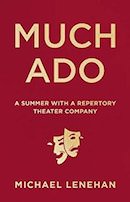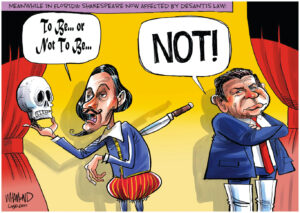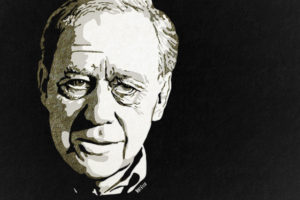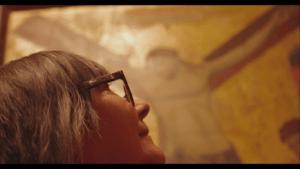Much Ado About Very Little
What does it take to put on a Shakespeare play in a Midwestern regional theater? A new book seeks to answer this question, but far more interesting questions are left unasked. Agate Midway
Agate Midway
“Much Ado: A Summer With a Repertory Theater Company”
A book by Michael Lenehan
What does it take to put on a Shakespeare play in a Midwestern regional theater? Who’s involved? What do they do?
Michael Lenehan’s “Much Ado: A Summer With a Repertory Theater Company” seeks to answer these basic questions. While he more or less succeeds in this straightforward endeavor, there are far more interesting questions that unfortunately are left unasked. Although “Much Ado” provides an excellent primer for theatergoers who are interested in the nuts and bolts of mounting a production, those with a deeper knowledge of theater will be left wanting more.

This reviewer belongs to the latter camp; as an actor I’ve performed in Shakespeare’s “Much Ado About Nothing,” the play that frames Lenehan’s book. I’ve also worked at a theater very similar to American Players Theatre (APT), where Lenehan immerses himself for the summer in question. So while my expectations of this book were undoubtedly high and perhaps a tad unfair, I was curious. I wanted to know how an outsider might perceive the mounting of one of Shakespeare’s best-known works, if provided an all access pass.
Lenehan begins with a history of APT, stuffed with places, dates and names. He mentions co-founding actor Randall Duk Kim, “who wanted a stage far from the coasts, which he found ‘too frantic’ for the kind of theater he wanted to do.” Following that, Lenehan plods through a timeline of APT’s lean years, before new management breathes life back into the struggling company, bringing us to 2014, when the Wall Street Journal’s drama critic praised it as “the best classical theater company in America.”
We then receive an introduction to the play in question, along with the principal players in Lenehan’s eyes: the actress playing Beatrice, Colleen Madden; her Benedick, David Daniel; and the director, David Frank. We are again treated to histories of each individual, places and names that would matter only if you knew those places and names:
“[Madden] wound up at the University of Delaware’s Professional Theatre Training program, a three-year classical program founded by Sanford [Sandy] Robbins, who had transplanted it to Delaware from the Milwaukee Campus of the University of Wisconsin.”
Lenehan struggles to inject some drama into the story of David Daniel’s casting, as he had never played a romantic lead in the theater. But the conflict doesn’t materialize; although Lenehan claims Daniel “was not among the company’s best-known actors,” everyone at APT called him “DD” and “he was beginning his fifteenth season there.” The casting of Daniel as Benedick isn’t exactly a shocker.
I understand Lenehan’s approach; these artists have lives prior to this particular production, and I can imagine it being interesting to see how their past affects (or doesn’t affect) their current duties in this specific play, but here, he misses one of the key lessons in theater: Exposition can be tough to make interesting.
The book finally begins to energize when more people become involved in the production. Like a magnet pulled through a pile of paper clips, the energy begins to make order out of seemingly disparate parts.
We meet set and costume designer Robert Morgan and hear about his negotiations with his director. Morgan isn’t completely sold on the final set design, but “whether the set was generic or expressive, Frank and Morgan agreed that above all it functioned well as a theatrical space.” We learn how Morgan takes the text and translates it into a color choice for a dress for Beatrice: “I said let’s give her something more energy. Not a vivid red, she’s not a gypsy, but a dark Indian red. It’s a deep shade, and it has warmth to it. I think it communicates maturity. But the color is vibrant like her soul, and her character.” Again, reality has its say, and “where a dressmaker might put delicate buttons or no fasteners at all, Beatrice’s bodice was equipped with heavy metal snaps, large zippers, and pull tabs to help the backstage dressers get it on and off in a hurry . . . (and) lined with cotton coutil, to minimize wear on the linen — the dress would be worn 30 times within 5 months — and absorb perspiration that might escape Madden’s camisole and corset.” We begin to understand that theater isn’t simply about expression and imagination, but the practice of bringing that imagined world into a usable, three-dimensional reality.
| To see long excerpts from “Much Ado” at Google Books, click here. |
But just as it is on the verge of a growing excitement, the book loses the narrative and digresses. There is a chapter on the “Shakespeare industry,” what being in “rep” means, a chapter called “The Trousers Dilemma” and one about the actor playing Leonato, the journeyman Brian Mani. Nothing is wrong with these tangents exactly, but they aren’t particularly interesting either, and Lenehan’s story of putting on a play begins to feel less like a story and more of an explanation. This is the second lesson of theater that Lenehan misses: Audiences (and readers) need a strong narrative, a story moving us forward, Aristotle’s dramatic action. Lenehan may be thoroughly explaining how theater is made, but rarely are we privy to the feeling of exhilaration one feels when making it.In the days and weeks leading up to opening night, Lenehan is provided unique access to spaces that are usually not available to outside eyes or ears: He listens to the shop-talk banter of the wig makers, he witnesses the intimate rehearsals of the actors and he watches the solitary, feverish work of the sound designer and composer John Tanner, who for six days will hole himself up in a motel room, “eating soup and chili, working twelve, sixteen, eighteen hours a day.” Producing a play involves many parts moving simultaneously, but missing from many of the interviews is the magical convergence between play and artist, and then the interplay between artist and audience.
When Lenehan takes the time to probe deeper, the book is at its best. There is a particular moment when Benedick makes a quiet, still confession of love to Beatrice, and Lenehan asks actor David Daniel how that moment came into being:
I can’t remember exactly, but it was probably something along the lines of, what do I say to her? I don’t know what to say. I want to take her; I want to grab her. As an actor I have a hundred choices I want to do right now that I know David [Frank, the director] won’t let me do, so as a actor, I’m frustrated. And as the character, Benedick, I’m frustrated; he doesn’t know how to express himself. So those layers are on top of each other, and then it’s like: Give up! Just give up. What’s the point? — says Benedick, and a little bit of David. Just sit down. David loved that moment. The most important line of the play, two backs … I’m facing upstage, away from the audience. They can’t see my lips move. I have to bounce the line off the back walls of the set and speak it strong enough to hit the audience, but with a kind of quality that makes it sound like, oh it just kind of fell off his shoulders. … David said to me, if we lose them, we’re going to lose them. But if we get them, we’ve got them. That’s on you. That’s your job, to make sure those words get out there. Don’t lose them. Don’t lose a single person.”
This nuanced exploration exemplifies how the actor, the director and the play can merge, resulting in a moment that is both unexpected and truthful. Theatrical gold. And yet, even in these discovered nuggets, those involved must always keep the audience in mind, in order for the jewel to be revealed. I wish the book included many more instances like these. Lenehan provides details, but I was hoping for magic.
In “Much Ado,” Lenehan manages to cull together an impressive assortment of information and backstage tidbits to give his readers a sense that, yes, there is much ado when it comes to mounting a stage production of this size and caliber. There are even moments where we witness artistry unfold. But in the end, while we learn how theater is made, the bigger questions are left unanswered: Why do these people devote their lives to their craft? Why does this particular play in this particular season for these particular people matter? Like an unlucky documentary filmmaker, Lenehan records hours of footage, but a story never quite develops. It seems that in theater as well as in writing, Robert Morgan the set designer had it right when he is quoted early on saying, “But is it going to be any good? Is it going to make sense later on? Sometimes it does, sometimes it doesn’t.”
Independent journalism is under threat and overshadowed by heavily funded mainstream media.
You can help level the playing field. Become a member.
Your tax-deductible contribution keeps us digging beneath the headlines to give you thought-provoking, investigative reporting and analysis that unearths what's really happening- without compromise.
Give today to support our courageous, independent journalists.






You need to be a supporter to comment.
There are currently no responses to this article.
Be the first to respond.